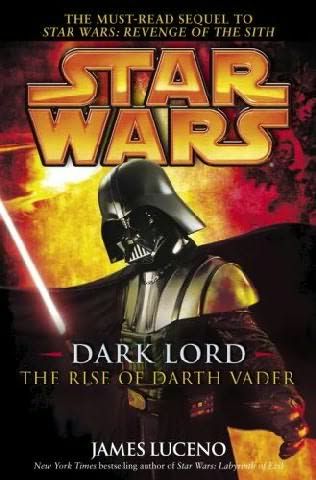
Dark Lord: The Rise of Darth Vader
by James Luceno
Seduces, deranged, and destroyed by the machinations of the Dark Lord Sidious, Anakin Skywalker is dead … and Darth Vader lives.
From the site of Anakin Skywalker’s last stand, where he sought to destroy his friend and former Master, Obi-Wan Kenobi, a fearsome specter in black has risen. Once the most powerful Knight ever known to the Jedi Order, he is now a disciple of the dark side, a lord of the dreaded Sith, and the avenging right hand of the galaxy’s ruthless new Emperor.
Meanwhile, on the Outer Rim world of Murkhana, Jedi Masters Roan Shryne and Bol Chatak and Padawan Olee Starstone are leading a charge on a Separatist stronghold, unaware that the tide has turned against them. Although the three narrowly elude execution, the deadliest threat still rests in the hideously swift and lethal crimson lightsaber of Darth Vader – behind whose brooding mask lies a shattered heart, a poisoned soul, and a cunning, twisted mind hell-bent on the vengeance. For the handful of scattered Jedi hunted across space, survival is imperative if the light side of the Force is to be protected and the galaxy reclaimed.
Here it is. The final book in the Revenge of the Sith trilogy I’ve been working on.
It’s a good book, but I think it falls flat in the wake of Revenge of the Sith. I wasn’t fond of Vader’s point of view; he was struggling with his new identity and that wasn’t anything I was interested in. Folks tend to get a bit mopey when they question themselves like that and mopey!Vader is just not my cup of tea. I did start to like his sections more towards the end of the book, when he was more sure of his new role and really actively started suppressing Anakin Skywalker, but I think the whole story would have been stronger without his personal thoughts.
Because the heart and strength of this book isn’t in Vader himself – it is in the idea of Vader and how the galaxy perceives him during his rise to power. The narration is strongest when Shryne and Starstone try to figure out who he is during their encounters and in the Moffs perceptions of a “civilian” of such high rank and in stormtrooper commanders trying to sort out precisely how they should be reacting to his orders. If this had been a book solely focused on how his deeds took him from a man with no rank and no addressed authority to the feared right hand man and executioner for the Emperor without stopping to check in on how he felt about it, then I would have been much more interested overall.
That being said, I did like the character of Roan Shryne as a Jedi who has been doubting his connection to the Force and has been more jaded with the universe than the other Jedi he has regular contact with. I also liked the few other Jedi who survived and how they survived, which supported some theories I had about the clone troopers and how the Jedi Temple ran missions. I thought the siege at Kashyyyk was very powerful and provided some useful set up for bits of the original trilogy and extended universe in the same era. And I liked the chapters with Bail Organa and how he was coping with the threat of the Empire overhead and the pressure from Mon Mothma to start opposing that threat as he keeps Leia safe and secret.
Again, overall, it’s a good book. I just think I was expecting more out of it. I would still recommend it to Star Wars fans if they have read Labyrinth of Evil by James Luceno and the Revenge of the Sith novelization by Matthew Stover. It does round out that story arc as a set up for the original trilogy and is a pretty good closing chapter on Anakin Skywalker.






No comments:
Post a Comment